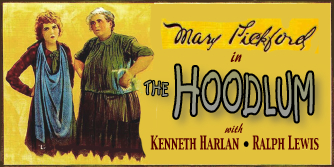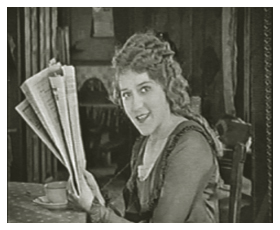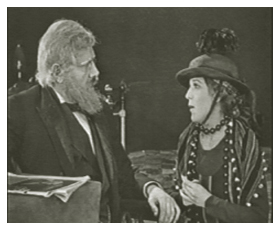

First National Pictures
Cast: Mary Pickford (Amy Burke), Ralph Lewis (Alexander Guthrie),
Kenneth Harlan (William Turner), Melvin "Buddy" Messinger
(Dish Lowry), Dwight Crittenden (John Burke), Aggie Herring (Nora),
Andrew Arbuckle (Pat O' Shaughnessy), Max Davidson (Abram Isaacs),
Paul Mullen (The pugilist).
"She had legions of imitators, but no rivals," said author, historian and producer Kevin Brownlow. (1) No truer words have been spoken about this megastar.
 He went on to say, "Her films
were almost always comedies, the light episodes being laced with
genuine pathos and much excitement. They were sentimental, but
seldom mawkish. The character of Mary Pickford was an endearing
little spitfire. She was delightful; she projected warmth and
charm, but she had the uncontrollable fire of the Irish."
(2) How aptly descriptive of this superstar - and one could swear
that Brownlow wrote these after watching "The Hoodlum"
because his description is right on target for her performance
in this delightful film.
He went on to say, "Her films
were almost always comedies, the light episodes being laced with
genuine pathos and much excitement. They were sentimental, but
seldom mawkish. The character of Mary Pickford was an endearing
little spitfire. She was delightful; she projected warmth and
charm, but she had the uncontrollable fire of the Irish."
(2) How aptly descriptive of this superstar - and one could swear
that Brownlow wrote these after watching "The Hoodlum"
because his description is right on target for her performance
in this delightful film.
The film, which has not been as readily available to collectors many of her other films, is a part of the Milestone Film & Video collection "Rags & Riches: The Mary Pickford Collection" which includes "The Poor Little Rich Girl" (1917) and "Sparrows" (1926). Admittedly, the other two films would win out over "The Hoodlum" in a "best film" contest, but let's not compare Pickford's films against one another. Instead, take a look around at Hollywood's output in 1919 - or throughout the entire silent era, for that matter - and you will find "The Hoodlum" to be thoroughly entertaining and head and shoulders above the average silent comedy.
Take note of the fact that the collection's title is "Rags & Riches," not "Rags TO Riches" - which wouldn't apply to "The Hoodlum." Actually, Pickford chose to go the opposite route and starts off as the rich young Amy Burke - pampered and definitely spoiled by her wealthy grandfather. An early temper tantrum defines her character and "spoiledness" well as she storms into one of her father's business meetings in the home, clad in her pajamas and carrying her cat, bemoaning, "Omar (the cat) had the most dreadful fits, and when you didn't come - I had hysterics." Her grandfather, however, is very patient with her brattiness, because the scene ends with the two hugging.
Amy's journey from riches to rags comes when her sociologist father arrives for a visit from England. He plans to live in the slums which, we are to understand, is necessary to write his book. Amy wants to be with her Dad, and, in spite of her grandfather's pleadings, she doe just that - not realizing the squalor to which she is about to subject herself.
The viewer may feel that Amy gets her "just desserts"
when she arrives in the slums in a limousine and well-dressed
only to be ridiculed and taunted by other girls her age. Of course,
her attitude when she arrives justifies the girls' distaste for
this new arrival. Two of them come to the apartment offering the
proverbial palm branch with "Say, Kiddo. We wants to be friends."
Amy gently removes the girl's hand from her shoulder and responds,
"I'm utterly fatigued. You will oblige me by leaving."
Ouch!
Amy becomes more disenchanted and unhappy in her new surroundings with each ensuing day. She sits on her bed sniveling, and we are shown the image of Amy in the midst of a pig sty to depict how she feels. At breakfast one morning, she reads in the paper how her father has left for Europe -- a trip he tried to convince her to take with him -- but she chose to go to the slums with her father instead.
Then a comment her father makes creates a pivotal point in the story. He tells her if she is to be happy, she must dress and act like "these people. You must treat them as your equals." Amy realizes this is her only way to be happy, so she not only takes his advice, she does it with unbridled enthusiasm.
No one could play the cheeky, tough kid in the slums like Mary Pickford - two excellent examples being "Amarilly of Clothesline Alley" (1918) and "Little Annie Rooney" (1925) - and "The Hoodlum" is classic Pickford. When she decides to act like "these people," the transformation (which we are told in an intertitle took place "after weeks of study") is remarkable.
For example, our first glimpse of the "new" Amy is on the ground in the alleyway shooting craps with three boys. Her attire has changed to an awful, long tight dress with huge vertical stripes, a string of large beads that must be 8 feet long, and a small hat with feathers on top that look as if they came off a duster. During the crap game, one of the boys accuses her of using loaded dice. Her friend, Dish (played very energetically by the 12-year old Buddy Messinger), starts to take up for her. She tells him, "Keep your shirt on, Dish - I'll handle this gink," - and she does, shoving him in the face and running him off. Not only has Amy learned the lingo of the neighborhood, she has become tough and feisty, as well! Soon, though, a cop arrives on the scene, and a chase ensues that would do justice to any of the better two-reel comedies of the day.
One very enjoyable side story involves the ongoing feud of two neighbors above Amy - the Irishman Pat O'Shaughnessy and the Jewish Issac Abrams (played, as always, superbly by Max Davidson) - and, of course, Amy takes it upon herself to bring the two together - which she does by the end of the story.
The viewer will also be delighted by an improvised dance
between Amy and Dish in the alleyway as an organ grinder plays
the music, various other young people taking their turn  as well, but none as adept as Amy and Dish.
Messinger deserves a lot of credit for hanging in their with Pickford
- and they both create a most entertaining duo (Fred and Ginger
have no worries, though!)
as well, but none as adept as Amy and Dish.
Messinger deserves a lot of credit for hanging in their with Pickford
- and they both create a most entertaining duo (Fred and Ginger
have no worries, though!)
There are several other enjoyable and comedic moments in the film such as this, but the story runs deeper. Across the alleyway is a handsome young man, William Turner (Harlan), with whom Mary converses occasionally from their fire escapes. He is an artist trying to sell his drawings to a publisher. However, he becomes a mysterious figure to us when we see him take some papers and hide them in a secret compartment of his drawing table.
Adding to the intrigue is a bearded man in cape and long black coat - displaying lots of cash - who comes into the boarding house where Amy and her father live to take a room. We soon find out that this is actually Amy's grandfather who has disguised himself and is using an assumed name so he can keep an eye on his granddaughter - and he is not pleased with what he sees!!
All of these pieces come together as we learn there is some history between Turner and Amy's grandfather - a case of Turner going to prison unjustly because of her grandfather. Amy's attraction for the young man leads her to help him in his attempt to prove his innocence - but that entails breaking into a safe in her grandfather's mansion!!
Unfortunately, "The Hoodlum" has gotten short shrift over the years, being considered one of Pickford's "lesser" comedies - which may account for its lack of circulation. Confirmed Pickford fan Edward Wagenknecht called it "a somewhat inconsequential slum comedy." (3) Admittedly, it's not the strongest of story lines, but the intrigue, the mystery and the emotion are strong enough to hold the viewer's interest for 92 minutes. Variety raved, "(Pickford) bestows not only herself . . . she gives the very best photography, direction, scenarios, lighting effects and attention to detail. In these technical respects, Paramount . . . never did anything better than 'The Hoodlum,' on view this week at the Strand." The reviewer goes on to say, "It is the type of feature that will sell, and it will sell like a wind travels." (4)
Variety makes a valid point when it says, "At times, Lippman's story is so mechanical . . . it does not convince." However, the reviewer is astutely perceptive in noting that "Mary Pickford is the picture." (5)
The New York Times took a harsher approach to its critique. "Miss Pickford's conversion from Fifth Avenue snob to hoodlum is not only insufficiently motivated in the story, but vastly overdone in the filming." (6) However, with Pickford, it is easy to step slightly outside of what may seem logical and enjoy her lighthearted and enchanting world. If one takes a look at Pickford's output during the silent era, the fact that she became the most famous and popular female star during those years certainly wasn't based on her films boasting the most outstanding stories from the period. Pickford was a true star whose charm and charisma stood head and shoulders above most others. She was an outstanding and accomplished actress. Her stories were made better than they really were by her presence, her insistence on quality filmmaking, her attention to details that would lift a story up just a little higher - just as the Variety reviewer so accurately observed.
Wagenknecht, who grew up going to Pickford movies in the
teens and twenties - and who met Pickford at the height of her
fame - probably describes the Pickford appeal best. "Make
 hatever qualifications and reservations
you like, for us Mary was sweetness and light, and this was more
important to us than any possible characterization. . . no other
generation will ever have her as we had her. If you say that you
do not understand how we were able to read such ineffable meanings
into her, I can only remind you of the painter and the lady who
could not see the effects of which he had spoken in the great
painting. ('Don't you wish you could, Madame?' he asked her. 'Don't
you wish you could?') - but none of that is very important. The
important thing is that we did it. And because we did it, we shall
cherish her in our hearts as long as we live, along with the memories
of our own youth, and be grateful in troubled times for the joy
she brought us." (7)
hatever qualifications and reservations
you like, for us Mary was sweetness and light, and this was more
important to us than any possible characterization. . . no other
generation will ever have her as we had her. If you say that you
do not understand how we were able to read such ineffable meanings
into her, I can only remind you of the painter and the lady who
could not see the effects of which he had spoken in the great
painting. ('Don't you wish you could, Madame?' he asked her. 'Don't
you wish you could?') - but none of that is very important. The
important thing is that we did it. And because we did it, we shall
cherish her in our hearts as long as we live, along with the memories
of our own youth, and be grateful in troubled times for the joy
she brought us." (7)
Although one would never know it in viewing the film, Pickford had not yet totally recovered from the influenza which swept the country and took so many lives in 1918 (including popular leading man Harold Lockwood with whom Pickford co-starring in"Tess of the Storm Country" and "Such a Little Queen" in 1914). After four weeks away from work in the spring of 1919, she returned to the Brunton Studios (later Paramount - where the New York slums were expertly created by art director Max Parker) against the doctor's advice. "The doctor told me I was crazy," she said, "and that he wouldn't be responsible for the consequences. But I don't think any outsider realizes the sense of obligation which motion picture stars feel in regard to their work. If the star is laid up, the whole picture stops. Dozens, perhaps hundreds of people have to be idle. So, you take your life in your hands, if necessary, to let the picture go on." (8)
It is likely very safe to say that there have been more words written about Mary Pickford than any other silent movie star. It is also safe to say that no name of a female star stands out in memory today more than Mary Pickford. She wasn't the most beautiful star. Her films were not the best to come out of the silent era. She had many competitors for best actress. But for some reason - some very hard to elucidate reason - we are drawn to her films, her smile, her eyes, the way she glides and dances across the screen. She can elicit laughter and pity within the same scene. She can amaze us with her superb acting or delight us with her silliness. She can be the little sister we want to protect and coddle - or she can be the romantic interest for a handsome leading man, and we understand the attraction. Whatever the reason, all we know is that we enjoy her films. She's left an enduring legacy that 100 years later brings us great pleasure and enjoyment. And, when the words "The End" finally appear on the screen, chances are we are smiling - and that, no doubt, is what Pickford wanted.
ENDNOTE: "The Hoodlum" was restored in 1998 by the Academy Film Archive, a branch of the Academy of Motion Picture Arts and Sciences. The Mary Pickford Foundation had preserved a copy on safety film, but it was somewhat incomplete. An additional scene that was not in the Mary Pickford library print was found at Eastman house. It was added to the print now available on the Milestone DVD for what is hopefully a complete print as seen in 1919. The orchestral score by Bonnie Ruth Janofsky and performed by the Rouse Philharmonic is excellent and particularly enjoyable on the Blu-Ray when heard through a surround sound system.
References:
1. Brownlow, Kevin. The Parade's Gone By, Bonanza
Books, 1968.
2. Ibid.
3. Wagenknecht, Edward. The Movies in the Age of Innocence.
University of Oklahoma Press. 1962.
4. Variety. "The Hoodlum" review. September 5,
1919.
5. Ibid.
6. The New York Times. "The Hoodlum" review.
September 1, 1919.
7. Wagenknecht.
8. Mullett, Mary B. "Mary Pickford Describes Her Most Thrilling
Experiences." American Magazine. May, 1923.
Copyright 2012 by Tim Lussier. All rights reserved